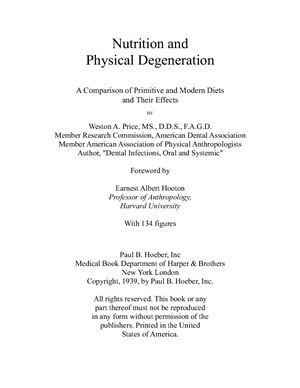Weston A. Price MS., D.D.S., F.A.G.D. Member Research Commission, American Dental Association.
Member American Association of Physical Anthropologists Author, “Dental Infections, Oral and Systemic”.
With 134 figures.
Paul B. Hoeber, Inc Medical Book Department of Harper & Brothers New York London.
Copyright, 1939, by Paul B. Hoeber, Inc, p. 445.
?????? ????? (Weston A. Price,1870-1948) ? ???????????? ??????????. ????????? ????????????? ???????? ????? ? ????????????? ????????????? ???????? ???????.
? ??????? ?????? ??? ???? ??????????????? ?????? ????????????? ?? ????? ???? (? ?? ????? ?????????????? ???? ?? ????? ?????), ???? ? ????? ????????? ??????? ????? ? ?????? ????? ? ???????? ????? ???????? ?????????. ?????????, ??? ???????? ? ?????? ???? ? ????????? ????????????? ??????? ???????, ? ?? ?????????? ???????????? ????????.
???????? ? ?????????? ???????????? ? ?????, ??????? ?????? ?????? ??????????? ?? ????? ?? ?????????? ???.
?????????? ???????? ?? ??????????????? ??????????? ??? ?????????? ??????????, ?????? ?? ???????????? ???? ? ??????????? ? ???????????? ??????? ? ?? ????????, ??? ? ???????? ??????????? ????? ??????????? ????????? ????????.
? ???? ????? ??????????? ?????? ????? ??????? ?????????? ?? ???????? ???? ??????? ????????? ? ???????? ???? ?????? ??????? ? ???????????? ?????????. ????????? ??? ???????? ????? ??????? ? ???????????? ??? ???? ???????? ????????, ????????? ??????? ?????? ? ????? ????? ???????, ?????? ????-?????????????? ???????, ????????????? ?????????, ?????????????? ?????, ?????????? ? ?????????? ???????, ? ????? ????????????? ???????? ??????????? ??????.
??? ???? ?????????? ??????????? ?????????? ?????????? ? ??????????? ?????? ??????????? ???????? ???? ? ??? ???????, ????? ?? ??????????? ???? ? ?????? ??????? ????????.More than sixty years ago, a Cleveland dentist named Weston A. Price decided to embark on a series of unique investigations that would engage his attention and energies for the next ten years. Possessed of an inquiring mind and a spiritual nature, Price was disturbed by what he found when he looked into the mouths of his patients. Rarely did an examination of an adult client reveal anything but rampant decay, often accompanied by serious problems elsewhere in the body such as arthritis, osteoporosis, diabetes, intestinal complaints and chronic fatigue. (They called it neurasthenia in Price?s day.) But it was the dentition of younger patients that gave him most cause for concern. He observed that crowded, crooked teeth were becoming more and more common, along with what Price called facial deformities?overbites, narrowed faces, underdevelopment of the nose, lack of well-defined cheekbones and pinched nostrils. Such children invariably suffered from one or more complaints that sound all too familiar to mothers of the 1990s: frequent infections, allergies, anemia, asthma, poor vision, lack of coordination, fatigue and behavioral problems. Price did not believe that such physical degeneration was God?s plan for mankind. He was rather inclined to believe that the creator intended physical perfection for all human beings, and that children should grow up free of ailments.Price?s bewilderment gave way to a unique idea. He would travel to various isolated parts of the earth where the inhabitants had no contact with civilization to study their health and physical development. His investigations took him to isolated Swiss villages and a windswept island off the coast of Scotland. He studied traditional Eskimos, Indian tribes in Canada and the Florida Everglades, Southsea islanders, Aborigines in Australia, Maoris in New Zealand, Peruvian and Amazonian Indians and tribesmen in Africa. These investigations occurred at a time when there still existed remote pockets of humanity untouched by modern inventions; but when one modern invention, the camera, allowed Price to make a permanent record of the people he studied. The photographs Price took, the descriptions of what he found and his startling conclusions are preserved in a book considered a masterpiece by many nutrition researchers who followed in Price?s footsteps: Nutrition and Physical Degeneration. Yet this compendium of ancestral wisdom is all but unknown to today?s medical community and modern parents.Nutrition and Physical Degeneration is the kind of book that changes the way people view the world. No one can look at the handsome photographs of so-called primitive people?faces that are broad, well-formed and noble?without realizing that there is something very wrong with the development of modern children. In every isolated region he visited, Price found tribes or villages where virtually every individual exhibited genuine physical perfection. In such groups, tooth decay was rare and dental crowding and occlusions?the kind of problems that keep American orthodontists in yachts and vacation homes?non existent. Price took photograph after photograph of beautiful smiles, and noted that the natives were invariably cheerful and optimistic. Such people were characterized by splendid physical development and an almost complete absence of disease, even those living in physical environments that were extremely harsh.The fact that primitives often exhibited a high degree of physical perfection and beautiful straight white teeth was not unknown to other investigators of the era. The accepted explanation was that these people were racially pure and that unfortunate changes in facial structure were due to race mixing. Price found this theory unacceptable. Very often the groups he studied lived close to racially similar groups that had come in contact with traders or missionaries, and had abandoned their traditional diet for foodstuffs available in the newly established stores?sugar, refined grains, canned foods, pasteurized milk and devitalized fats and oils?what Price called the displacing foods of modern commerce. In these peoples, he found rampant tooth decay, infectious illness and degenerative conditions. Children born to parents who had adopted the so-called civilized diet had crowded and crooked teeth, narrowed faces, deformities of bone structure and reduced immunity to disease. Price concluded that race had nothing to do with these changes. He noted that physical degeneration occurred in children of native parents who had adopted the white man?s diet; while mixed race children whose parents had consumed traditional foods were born with wide handsome faces and straight teeth.
The diets of the healthy primitives Price studied were all very different: In the Swiss village where Price began his investigations, the inhabitants lived on rich dairy products?unpasteurized milk, butter, cream and cheese?dense rye bread, meat occasionally, bone broth soups and the few vegetables they could cultivate during the short summer months. The children never brushed their teeth?in fact their teeth were covered in green slime?but Price found that only about one percent of the teeth had any decay at all. The children went barefoot in frigid streams during weather that forced Dr. Price and his wife to wear heavy wool coats; nevertheless childhood illnesses were virtually nonexistent and there had never been a single case of TB in the village. Hearty Gallic fishermen living off the coast of Scotland consumed no dairy products. Fish formed the mainstay of the diet, along with oats made into porridge and oatcakes. Fishheads stuffed with oats and chopped fish liver was a traditional dish, and one considered very important for children. The Eskimo diet, composed largely of fish, fish roe and marine animals, including seal oil and blubber, allowed Eskimo mothers to produce one sturdy baby after another without suffering any health problems or tooth decay. Well-muscled hunter-gatherers in Canada, the Everglades, the Amazon, Australia and Africa consumed game animals, particularly the parts that civilized folk tend to avoid?organ meats, glands, blood, marrow and particularly the adrenal glands?and a variety of grains, tubers, vegetables and fruits that were available. African cattle-keeping tribes like the Masai consumed no plant foods at all?just meat, blood and milk. Southsea islanders and the Maori of New Zealand ate seafood of every sort?fish, shark, octopus, shellfish, sea worms?along with pork meat and fat, and a variety of plant foods including coconut, manioc and fruit. Whenever these isolated peoples could obtain sea foods they did so?even Indian tribes living high in the Andes. These groups put a high value on fish roe which was available in dried form in the most remote Andean villages. Insects were another common food, in all regions except the Arctic. The foods that allow people of every race and every climate to be healthy are whole natural foods?meat with its fat, organ meats, whole milk products, fish, insects, whole grains, tubers, vegetables and fruit?not newfangled concoctions made with white sugar, refined flour and rancid and chemically altered vegetable oils.
Price took samples of native foods home with him to Cleveland and studied them in his laboratory. He found that these diets contained at least four times the minerals as the American diet of his day. Price would undoubtedly find a greater discrepancy in the 1990s due to continual depletion of our soils through industrial farming practices. What?s more, among traditional populations, grains and tubers were prepared in ways that increased vitamin content and made minerals more available?soaking, fermenting, sprouting and sour leavening.
It was when Price analyzed the fat soluble vitamins that he got a real surprise. The diets of healthy native groups contained at least ten times more vitamin A and vitamin D than the American diet of his day! These vitamins are found only in animal fats?butter, lard, egg yolks, fish oils and foods with fat-rich cellular membranes like liver and other organ meats, fish eggs and shell fish.
Price describes the fat soluble vitamins as catalysts or activators upon which the assimilation of all the other nutrients depended?protein, minerals and vitamins. In other words, without the dietary factors found in animal fats, all the other nutrients largely go to waste.
In Nutrition and Physical Degeneration, Price discusses another fat soluble vitamin that was a more powerful catalyst for nutrient absorption than vitamins A and D. He called it Activator X. All the healthy groups Price studied had the X Factor in their diets. It could be found in certain special foods which these people considered sacred?cod liver oil, fish eggs, organ meats and the deep yellow Spring and Fall butter from cows eating rapidly growing green grass. When the snows melted and the cows could go up to the rich pastures above their village, the Swiss placed a bowl of such butter on the church altar and lit a wick in it. The Masai set fire to yellow fields so that new grass could grow for their cows. Hunter-gatherers always ate the organ meats of the game they killed?often raw. Liver was held to be sacred by many African tribes. The Eskimos and many Indian tribes put a very high value on fish eggs. Activator X is now believed to be the fat-soluble vitamin K2; read Chris Masterjohn?s article to see how this 60-year mystery was finally solved.
Nutrition and Physical Degeneration has as much relevance today as it did 60 years ago. The book includes Price?s unforgettable photographs showing the superb dentition and facial development of peoples living on nutrient-dense foods. All who plan to bear children and everyone in the practice of medicine should read this book.
– See more at: http://www.westonaprice.org/.
Physical
{pdf} Price. Nutrition and Physical Degeneration: A Comparison of Primitive and Modern Diets and Their Effects Weston A.
$19.99






Reviews
There are no reviews yet.